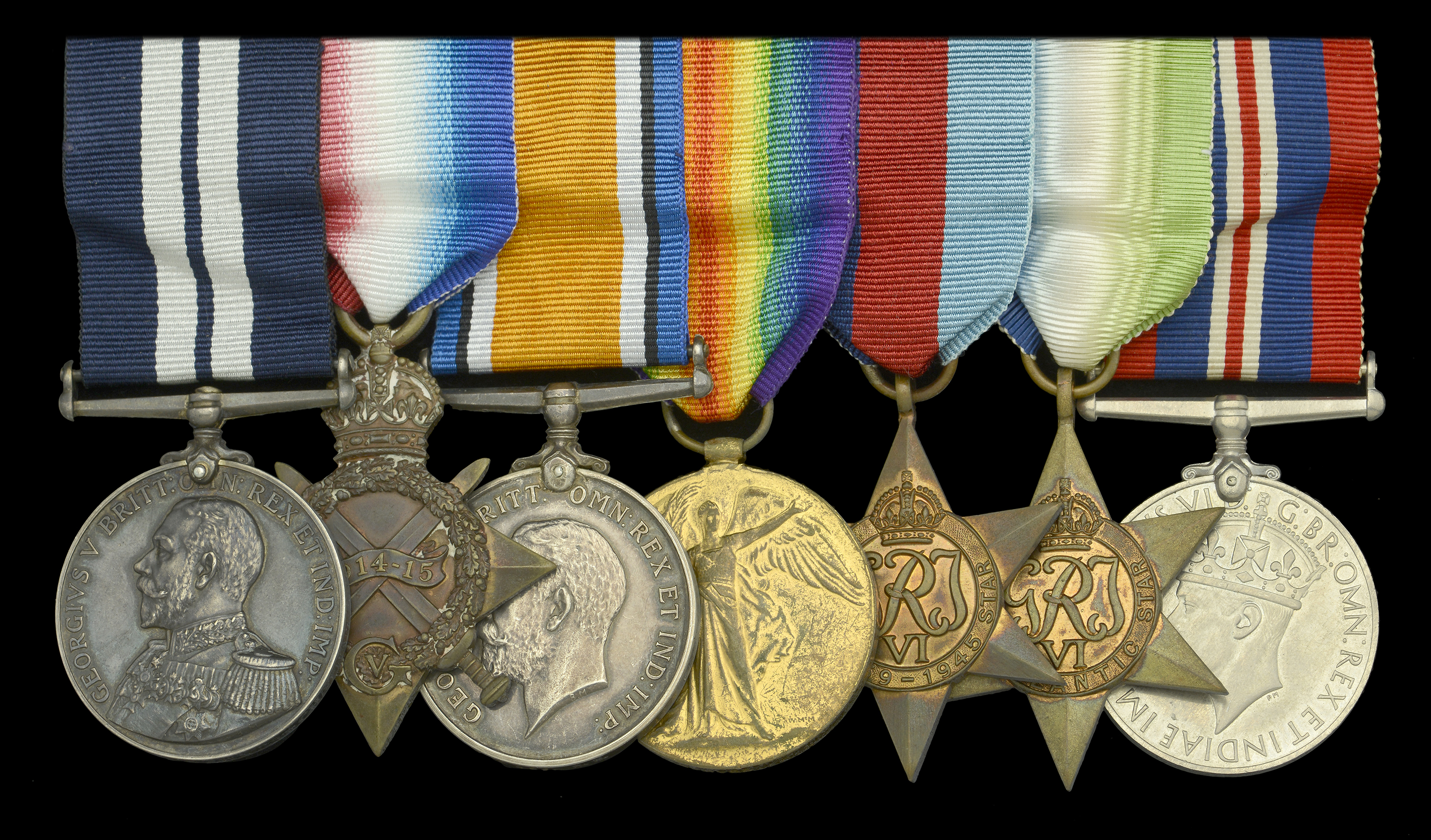A scarce Great War ‘East Africa’ D.S.M. group of seven awarded to Gunner A. S. Rose, Royal Navy, for his services as one of the volunteers from H.M.S. Chatham who crewed and took part in the sinking of the collier Newbridge on 10 November 1914, to block the Suninga branch of the Rufiji delta, Rose himself acting as helmsman on the upper bridge Distinguished Service Medal, G.V.R. (236177 A. Rose, P.O., H.M.S. Chatham.); 1914-15 Star (236177 A. Rose. P.O., R.N.); British War and Victory Medals (Gnr. A. Rose. R.N.); 1939-45 Star; Atlantic Star; War Medal 1939-45, mounted as worn, extremely fine (7) £1,400-£1,800 --- Importation Duty This lot is subject to importation duty of 5% on the hammer price unless exported outside the UK --- --- D.S.M. London Gazette 19 November 1915. “I have the honour to forward herewith a list of ratings specially recommended for the Distinguished Service Medal for services in East Africa... These men all took part in the sinking of the collier Newbridge on 10 November 1914 to block the Suninga branch of the Rufigi delta... Volunteers were called for onboard Chatham to form the crew of Newbridge, but as everyone volunteered the ratings were specially selected. I considered the operation a very hazardous one for them owing to the narrowness of the river where the ship had to be sunk and the difficulties of having to get away from the ship and of sinking her. That this was done with such little loss was due to their own coolness and able and successful handling of the Newbridge and covering steamboats, whose fire undoubtedly caused that of the Germans to become very wild during our return down the river... Alfred Rose, Leading Seaman ON 236177 (now Petty Officer) Acted as helmsman in Newbridge on upper bridge” (ADM 137/15 refers). Operations against the Königsberg In November 1914 alarm over a possible breakout shaped the next move. The objective now was not to sink Königsberg but to cork her up in the delta river, which amounted to the same thing. This would be done by scuttling a blockship in the channel of the Suninga outlet, which at that time was thought to be the German cruiser's only avenue of flight. The vessel chosen to act as the plug was a flat-bottomed thirty-eight-hundred-ton Admiralty collier named Newbridge. Her holds filled with dynamite charges and rubble, she would steam into the Suninga entrance and anchor bow and stern athwart the channel, at which point the crew would open her sea cocks, board an escorting ship's boat and detonate the charges by remote-control firing circuits. It was that simple. It was also suicide: anchoring in the Suninga channel would provide target practice for the Delta Force guns at point-blank range. But when Drury-Lowe called for volunteers, Chatham's entire ship's company stepped forward. Fourteen officers and men were chosen to man Newbridge. “I hardly ever expected to see them again," said Drury-Lowe. The operation was scheduled for November 10. Some attempt to reduce the risk was made by putting up steel plates and sandbags around Newbridge's wheelhouse, afterdeck and forecastle. As in the abortive torpedo attack, three armed steam cutters and the old Duplex were assigned to escort the collier, while the cruisers would stand in as close as possible to provide at least token cover with their big guns. Drury-Lowe also tried for an element of secrecy by arranging to have the miniature convoy enter the channel just before dawn. No one was caught napping. At exactly 5:25 a.m., as Newbrige crept past the Suninga entrance, the Delta Force, still unseen but very much in evidence, set the channel aboil with every gun it could bring to bear. For the next hour, the sodden air of the lower delta reverberated with the bark of 47-mm. guns and the clatter of machine guns, occasionally cried out when a shell burst against the steel plates of the blockship or the protected hull of one of the escorts. But Newbridge's crew behaved as if the whole thing were a dry run. At 5:50, almost hidden by the blossoms of exploding shells, the ex-collier was jockeyed into position astride the fairway. At a quiet order from the bridge, bow and stern anchor chains rumbled out while the volunteer skipper, Commander Raymond Fitzmaurice, signaled "Finished with engines." Newbridge might have been coming to anchor in Southampton roads. At that very moment, a steam cutter glided alongside, took off Newbridge's crew, and the four escort craft steamed hastily - but still in formation - through the rain of steel toward open water. At 6:15, Fitzmaurice pushed the plunger that set off the charges in the blockship. There was a thundering belch as Newbridge gave a great shudder and then began to settle in the water. Within minutes, only her upper works could be seen. By this time. the escort vessels had made good their escape through the channel mouth. Of the five dozen officers and men in the operation, two had been killed by shell fragments; nine others were badly sliced up but remained alive. By rights, all should have been feeding the crocodiles in the Suninga. Later that afternoon, a jubilant Admiralty announced to the world that Königsberg was “now imprisoned and unable to do any more damage.” It was a premature claim, as history would relate. Alfred Sydney Rose was born at Thorpe le Soken, Essex, on 18 June 1889, and joined the Navy as a Boy 2nd Class in H.M.S. Ganges on 5 January 1906, an errand boy by trade. He served aboard H.M.S. Chatham as Leading Seaman and Petty Officer from 3 December 1912 to 25 February 1916. After further service at Pembroke I and onboard H.M.S. Erebus, he was promoted Acting Gunner on 6 February 1918, and transferred to the Officer’s Section. Alfred Sidney Rose, D.S.M., Gunner, H.M.S. Mooltan, died of illness on 15 January 1941, aged 51. He is buried in Tynemouth (Preston) Cemetery, Northumberland.





